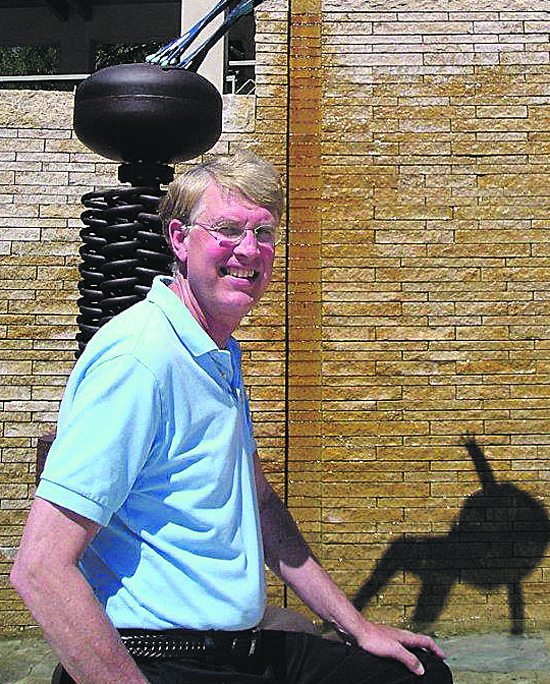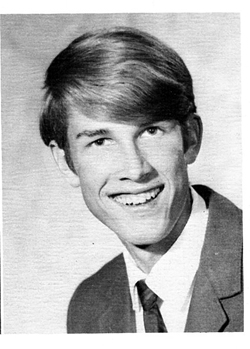| | Published August 17th, 2011
| Recreation Time for Todd Skinner
| | Cathy Dausman |  | | Todd Skinner today, a retired and content Orindan Photo Cathy Dausman
|
Todd Skinner says he's gained a new perspective. The newly retired Director of Parks and Recreation for Orinda sits under umbrella shade near the library and contemplates the outside of the old Orinda Elementary School, his work home for 31 years. That building, which used to be painted bright blue, is the city's Community Center. The Center, he says "brings people together here even more than what they're doing." Yet Skinner never walked inside until starting what he calls his "rewarding and fulfilling career."
 Skinner admits he was surprised "that Orinda got a Community Center," and surprised "that there was a career here for me." Before the 1970's Orinda had no park or community center and the Lamorinda native thought he'd have to look elsewhere for work in his field.
Skinner admits he was surprised "that Orinda got a Community Center," and surprised "that there was a career here for me." Before the 1970's Orinda had no park or community center and the Lamorinda native thought he'd have to look elsewhere for work in his field.
 Skinner's first post-college job earned him $6 an hour in Berkeley as assistant camps director. He stayed three and a half years. Then his wife noticed an ad for a recreation director in Orinda. Skinner took the job in 1980 and the next three decades are his history.
Skinner's first post-college job earned him $6 an hour in Berkeley as assistant camps director. He stayed three and a half years. Then his wife noticed an ad for a recreation director in Orinda. Skinner took the job in 1980 and the next three decades are his history.
 Skinner arrived at the "tail end of old Orinda," before the city had incorporated, when it was a county designated service area known as R-6. It was the first of three distinct eras of his tenure. Recreation classes then were mostly cooking classes geared to stay-at-home moms. "We sometimes ran ten classes," Skinner recalls, "but they were always filled."
Skinner arrived at the "tail end of old Orinda," before the city had incorporated, when it was a county designated service area known as R-6. It was the first of three distinct eras of his tenure. Recreation classes then were mostly cooking classes geared to stay-at-home moms. "We sometimes ran ten classes," Skinner recalls, "but they were always filled."
 Back then it wasn't unusual for the city to have 80 parks and recreation volunteers. "We were the thing that was happening," he says. Orinda was "rallying around the community center, and rallying around the park." The Orinda Parks and Recreation Foundation with its annual Black Tie party spearheaded the funding and drove the work along.
Back then it wasn't unusual for the city to have 80 parks and recreation volunteers. "We were the thing that was happening," he says. Orinda was "rallying around the community center, and rallying around the park." The Orinda Parks and Recreation Foundation with its annual Black Tie party spearheaded the funding and drove the work along.
 City incorporation in 1985 was the second phase of Skinner's employment. The once stand-alone recreation department became one of Orinda's "three P's: Police, Planning and Parks [departments]." The recreation department developed an array of child-friendly afternoon classes to assist families where both parents worked full time.
City incorporation in 1985 was the second phase of Skinner's employment. The once stand-alone recreation department became one of Orinda's "three P's: Police, Planning and Parks [departments]." The recreation department developed an array of child-friendly afternoon classes to assist families where both parents worked full time.
 One secret to the Orinda Community Center's success, and thus the Parks and Rec Department programs, says Skinner, is that its centralized location attracts participants from outside Orinda. He says nearly 35% of class attendees come from places like Berkeley, El Sobrante and the Upper Happy Valley area of Lafayette. "The [recreation] center works and always will work," he emphasizes.
One secret to the Orinda Community Center's success, and thus the Parks and Rec Department programs, says Skinner, is that its centralized location attracts participants from outside Orinda. He says nearly 35% of class attendees come from places like Berkeley, El Sobrante and the Upper Happy Valley area of Lafayette. "The [recreation] center works and always will work," he emphasizes.
 Today's Parks & Rec clients are both children and adults; with special interest evening classes for adults. The Ballet Academy and theater program are up and running and the city hired a Camps Director for K-8 students. With all the changes throughout the years, Orinda city population (17,648 as of the 2010 US census) hasn't budged much since the start of Skinner's career.
Today's Parks & Rec clients are both children and adults; with special interest evening classes for adults. The Ballet Academy and theater program are up and running and the city hired a Camps Director for K-8 students. With all the changes throughout the years, Orinda city population (17,648 as of the 2010 US census) hasn't budged much since the start of Skinner's career.
 Skinner calls his final era the building boom. The Community Center was remodeled and the Wagner Ranch Gym built in 1997, the new library in 2001, and a new City Hall opened in 2007. Orinda developed a "more aggressive park dedication ordinance," under former City Manager Bill Lindsay, and sought out more park space. Orinda Oaks Park, originally planned as 11 acres, ultimately grew to the 110 acre Orinda Oaks Open Space Preserve.
Skinner calls his final era the building boom. The Community Center was remodeled and the Wagner Ranch Gym built in 1997, the new library in 2001, and a new City Hall opened in 2007. Orinda developed a "more aggressive park dedication ordinance," under former City Manager Bill Lindsay, and sought out more park space. Orinda Oaks Park, originally planned as 11 acres, ultimately grew to the 110 acre Orinda Oaks Open Space Preserve.
 Skinner has seen some exciting changes in his department since 1980, including the Wilder Development. When Wilder is complete, the city's recreational acreage will more than double. The first two, of five, planned playing fields (lighted and designed with artificial turf for year -round use) are scheduled to open in November. "I'll be there when they open," he says, because "this is Orinda's new recreation frontier." Skinner plans to hike the entire length of Wilder trails, from Orinda south to San Leandro someday.
Skinner has seen some exciting changes in his department since 1980, including the Wilder Development. When Wilder is complete, the city's recreational acreage will more than double. The first two, of five, planned playing fields (lighted and designed with artificial turf for year -round use) are scheduled to open in November. "I'll be there when they open," he says, because "this is Orinda's new recreation frontier." Skinner plans to hike the entire length of Wilder trails, from Orinda south to San Leandro someday.
 Art in Public Places was the last project with which Skinner was involved, and he shares credit with Ted Urban. Works from dozens of regional artists have been loaned to Orinda and exhibited for a year throughout the library and plaza, the Community Center, and City Hall. When the city saved to purchase two of the more popular pieces, three other artists stepped up with permanent donations.
Art in Public Places was the last project with which Skinner was involved, and he shares credit with Ted Urban. Works from dozens of regional artists have been loaned to Orinda and exhibited for a year throughout the library and plaza, the Community Center, and City Hall. When the city saved to purchase two of the more popular pieces, three other artists stepped up with permanent donations.
 Recently returned from an Echo Lake vacation, Skinner seems relaxed but involved as he helps his wife complete a home kitchen remodel and contemplates his future. By way of goodbye, he says simply, "Something new is good for the city." It seems that is true for buildings, careers and people.
Recently returned from an Echo Lake vacation, Skinner seems relaxed but involved as he helps his wife complete a home kitchen remodel and contemplates his future. By way of goodbye, he says simply, "Something new is good for the city." It seems that is true for buildings, careers and people.

|
 | | Todd Skinner as he appeared in the Miramonte High School yearbook, circa 1970
| | | | | | | | | | | Advertisement | | |
| | | print story
Before you print this article, please remember that it will remain in our archive for you to visit anytime.
download pdf
(use the pdf document for best printing results!) | | | Comments | | |
| | | | | | | | | | | | | | | | |



